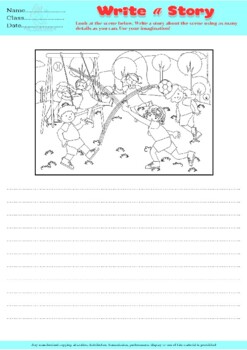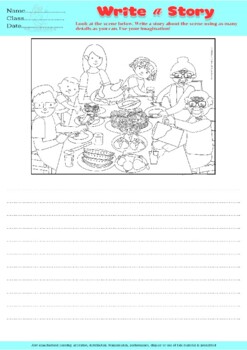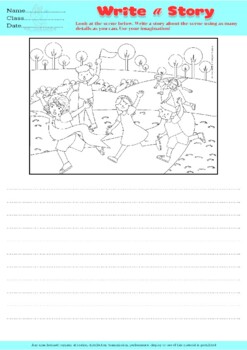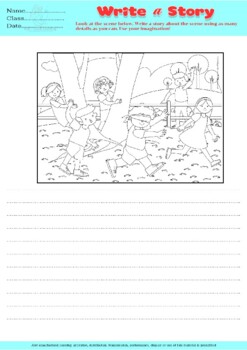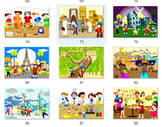Picture writing prompts, scenes for coloring, speech therapy, special education
- PDF
What educators are saying
Also included in
- Your students will LOVE these engaging picture scenes, and you will love the versatility of using them to address your students’ speech and language goals!Each scene has a beautiful illustration. You will meet the same group of beautiful children but they are doing different activities in each scenePrice $54.00Original Price $130.00Save $76.00
Description
Need a fun way to get your students to practice writing? Here are 87 engaging picture prompts that can be used many different ways. You get them in 2 sizes of line spacing: small (normal) and large.
There are 174 pages all together.
Your students will LOVE these writing prompts with engaging picture scenes, and you will love the versatility of using them to address your students’ speech and language goals!
Each scene has a beautiful illustration. You will meet the same group of beautiful children but they are doing different activities in each scene. This is my own idea, and for sure you have never seen any material like that before.
Picture scenes are a versatile and engaging tool to use in speech therapy. You can use them to teach your students vocabulary, sentence formulation, WH questions, comparing/contrasting, giving directions, defining/describing, making predictions, and explaining similarities and differences.
These picture scenes are great for mixed groups, substitute lesson plans, language sampling, progress monitoring, storytelling, and articulation carryover!
HOW TO USE PICTURE SCENES IN SPEECH THERAPY
WRITINGS
This pack is perfect for students to build confidence in writing.
Do your students have writer’s block when it comes to narrative writing? If so, they will love these picture writing prompts. These picture prompts are sure to get your kids writing with more ease and with more creativity.
Use them in your writing centers, as journal prompts, and as morning work. Just display one page every morning and see your students starting their day off with a smile and the motivation to write!
Print in color and laminate so your kids can use dry erase markers to write and wipe. Also feel free to copy them in black and white and add them to your writing center.
More Uses:
• These picture prompts can also be used in a number of other ways. Students can practice sequencing words, cause and effect, journal writing, generating questions and assessment of oral language as well as conversation practice.
There are two levels of questions:
Level 1 questions include present tense, present progressive, simple past, yes/no questions, giving descriptions and "wh-" question words.
Level 2 questions include future tense, giving explanations, providing opinions, "why" questions, compare/contrast, "if", and "should", write a "conversation" or "short story".
CONVERSATIONS
I love to use scenes to work on conversational turn-taking or initiating conversations. Present your student (or let them choose) a picture and have them start a conversation based on it. You may also see how many times you, or two students, can go back and forth with questions/comments about the picture.
VOCABULARY
Many of these scenes have a theme. Use these themes to teach vocabulary and discuss associations, categories, and negation.
VERBS
All of these scenes are packed with people doing things. This makes them perfect to talk verbs – present, past, or present progressive. I like to use these scenes as a generalization tool for this instead of the beginning stages of teaching verbs. Use the scenes to point to a character and ask: What is she doing? What did he do? What do you think they are going to do?
WH QUESTIONS
Use the scenes to work on answering various questions correctly: Who is that? What is that? Why is he happy? Where is the bird? When do you use an umbrella? It’s easy to come up with different types of WH question to ask with the variety of scenes and many things happening in each one.
SENTENCE FORMULATION
Have your student work on sentence formulation with an engaging scene of their choice. Ask them to describe something they see. If needed, prompt your student with a more specific question, such as: Tell me what the girl did. Use a sentence scaffold to focus the sentences on including something specific, for example, pronouns or past tense verbs. (eg. He/she + is + -ing.)
FOLLOWING DIRECTIONS
Give simple 1-step directions or complex multi-step directions! For example, “Point to the car” or “Touch the girl with pink dress, then find the boy singing, and last point to the smallest apple”.
INFERENCES
These fun scenes are great for making inferences. Why do they wear jackets? Why are the kids laughing? Why is she crying?
NOUNS & PRONOUNS
Since these pictures are packed with people, it’s easy to work on nouns (boy, girl) and pronouns (he, she, they, his, hers, theirs). Ask: Who is that? Who is sleeping? Whose toy is it?
PREPOSITIONS
Discuss where the scenes are: outside, inside, at the park. You may also test generalization skills of various prepositions: in, on, under, near, far, between, in front, between, above, below or prepositional phrases.
Coloring books that teach certain subjects through illustrations can be an engaging (and playful!) way for your child to learn. Sit down with your child and have a fun conversation about what she’s coloring. If your child doesn’t know something about the topic, then you can share more about it. This way, kids will associate learning with having fun and spending extra time with you.
As you may have noticed, young children love colour! It catches their eye and grabs their attention. A baby is born with monochrome vision and is unable to distinguish the difference between colours, it is not until around eight months when their colour vision is fully developed. By three to four years, a child can begin to recognise and name basic colours as frequent exposure can help strengthen this skill.
The product contains 87 pages x 2 for colouring. Please note that they are all black and white pages for colouring. If you want to buy this set which has already been coloured, please visit this link:
BEAUTIFUL COLOURING PAGES
Your students will LOVE these engaging picture scenes, and you will love the versatility of using them to address your students’ speech and language goals!
Included are 87 picture scenes x 2. Each scene has a beautiful illustration. You will meet the same group of beautiful children but they are doing different activities in each scene. This is my own idea, and for sure you have never seen any material like that before.
Picture scenes are also a versatile and engaging tool to use in speech therapy. You can use them to teach your students vocabulary, sentence formulation, WH questions, comparing/contrasting, giving directions, defining/describing, making predictions, and explaining similarities and differences.
These picture scenes are great for mixed groups, substitute lesson plans, language sampling, progress monitoring, storytelling, and articulation carryover!
Colour is not only exciting for a child, but it also helps with their learning.
That Magical Moment Your Preschooler Starts Coloring Inside the Lines is fantastic and you should never forget. This simple skill shows that your child's cognitive capabilities are growing in fundamental ways.
It seems to happen overnight: Your child goes off to preschool, a master of scribbling. Then, she hands you a piece of artwork that shows she’s tried to color inside the lines for the first time. It’s a big moment — and you deserve to do your proud parent dance as you tape that page to the fridge.
That switch in coloring skills is a milestone for children because it shows that their motor skills and cognitive skills are developing. It’s one of many developmental milestones children tend to reach between three to five years of age, but experts advise against explicitly asking children to color within the lines, which could make the activity feel tedious. If your preschooler is still scribbling, not to worry! Every child develops specific skills at different times. If she can’t color inside the lines once she enters first grade, talk to her teacher and pediatrician to determine if a vision test or other assessment is needed.
1. Helps Develop Hand-Strength
One of the biggest reasons coloring is important is because it helps develop hand strength. As adults, we’ve been writing, typing, and doing fine motor skills for decades which means we take our hand strength for granted. Toddlers and preschoolers, however, are just beginning to build those muscles.
Hand strength is important for all hand-related fine motor skills, especially handwriting. Writing takes strength and dexterity, and coloring helps exercise these muscles. Hand strength will also support your child’s proper pencil grip.
2. Offers Practice for Pencil Grip
A crayon is likely one of the first writing instruments your child will hold. By practicing with crayons, your child is fine-tuning their proper pencil grip. Pencil grip is part hand strength and part practice. Coloring allows for both! Most improper hand grips are caused when a child develops poor grip habits before their hands are strong enough to support the proper grip.
3. Stimulates Creativity
Giving a child the opportunity to color helps stimulate the creative centers in their mind. Colors, shapes, interpretations, and imagined stories are all present when a child is coloring. Even if your child draws the same picture over and over, they’re still engaging the creative centers in the brain that process colors and shapes.
4. Encourages Self-Expression
When children have the opportunity to color, they engage their independence and self-expression. What colors should they choose? What should they draw? What will it look like? Will it be big or small? Will it have lots of colors or just one color? Will the faces be smiling or frowning? Chances are, the answers to their questions are either consciously or subconsciously expressing themselves or their emotions. Drawing is a chance for your child to work through his or her emotions and to express themselves in a safe environment. Children may not always have the words to say exactly how their feeling, but coloring will let your child express himself without needing the vocabulary to do so.
5. Improves Fine Motor Coordination
In early childhood, children are still developing the fine motor coordination skills that will eventually support their daily activities. Typing, writing, cooking, household chores, turning pages of a book, using tools, doing their hair — pretty much everything requires motor skills. When your child colors, he or she is developing their fine motor coordination. Other coloring-related activities that help develop fine motor coordination include dot-to-dot pictures, tracing, coloring inside the lines of coloring pages, playing tic-tac-toe, and copying a picture onto a blank sheet of paper.
6. Helps Develop Focus
Coloring is also a great focus-building exercise. Focus is an important skill for children to learn, not only for their academic careers but for their professional careers as well. Focus is what helps us see through any task from start to finish. You’ll notice as your child’s focus develops that his or her drawings become more intricate, taking more time to complete.
© 2020 QUYNH CHOLEVA ALL RIGHTS RESERVED
Any unauthorized copying, alteration, distribution, transmission, performance,
display or other use of this material is prohibited.

